





Spirals in history Volutes of the baroque. Volutes of the brazilian baroque Were there spirals during middle ages? What happened in Kopenhagen, in the XVII century?
Spirals of the psychedelic period Spirals in Science.
Spirals in the western history Spirals in Esoterics. Spirals and Coriolis |
Significant Insignificances We have been overexposed, in the years about the second Millenium, to a myriad of spirals, but you probably did not notice it. This page will give some examples of that pervasiveness. Most of it is just cheap repetition, but is there a telluric movement underneath the designer's choice? This page does not reach an answer to that question, but tries to list the evidence. As a materials scientist, I am compelled to explain behavior, based on characteristics of the microstructure. Significance will only be reached, in this subject, if we find something immanent in the spiral use through history. As we show here, spirals have had moments of unbearable brightness, followed by moments of oblivion. Even if nothing is ever found, I must say it has been interesting to look through time using spiral as a bias. It is like looking at the world through a kaleidoscope. |
In the last few years, spirals were used in fonts, logos, fabrics,
backgrounds, everywhere.
It is funny how those images can be everywhere and we don't notice it.
You wont find, in the magazines of the 80's and 70's, such a
plethora of spirals.
Its use might have been induced by the internet @ge. Could be a sign of been up-to-date. On another trend, somehow a spiral has been introduced to mediate the ageless connection between fun, summer and the sun, and the spiral end up inside the sun, in logos and advertisements related to the summer. Spiral and summer? At the same time, the NewAge people adopted it. Just try to write "spiral - stair" (for obvious reasons) in a search machine and you will be drowned by witches of all sorts. There you can think of the relation to all the growing spirals of Nature. Spirals and growth.
Did the fortuitous choice of the @ by someone in the ARPAD sparked the spinning of spirals all around the globe? Once it became fashionable, than it is reproduced just by laziness of the fashion creators? Could be just that. Add to that the eternal cycle that opposes the straight line to the curve, Apollo versus Dionysus. After the geometric abstraction domination of the 80's, in Y2K the spiral is the forefront of the Curly Party.
But it may also have a broader meaning, something the historians
will see
100 years from now. That is the thrill: can you feel the pulse of
history while you live your life? Or are we slaves of telluric forces
driven by the collective unconsciousness?
Spirals in Logos
This is the favorite place for spirals. So much that some designers got
fed up with its use, and began to depreciate it. They even gave the
spiral a nickname. Grant Hutchinson, for example, he has a page about
logos. If want more, go to http://splorp.com/critique/
 |
 |
 |
   |
|
| Paper Gifts | Restaurant in Rio |
Spirals
in Fonts of the 90's
 |
 |
 |
 |
| Swatch, may 2001,
Germany |
Chicco, 1999,
Italy |
McDonalds, 1999 Brazil |
carnival of 2000, Brazil |

|
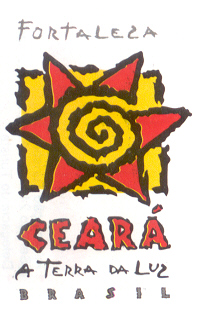 |
 |
 |
|
| Restaurant 2000 |
Ceará State Symbol, 2000 | Tennis Shoes 1999 |
Hotel 2000 |
Spirals in Fabrics
In fabrics the presence of spirals is ageless, it has been always
present. Maybe what has changed is a certain abandonment of the
"natural" spiral, the one that imitates nature, for the use of
isolated spirals, the form in itself.
Spirals as graffite
It seems that whenever you need to fill spaces with something,
spirals are a good choice.
 |
 |
|||
| Disney, 1997 |
language school, Brazil, 1999 |
Spirals everywhere
 |
 |
 |
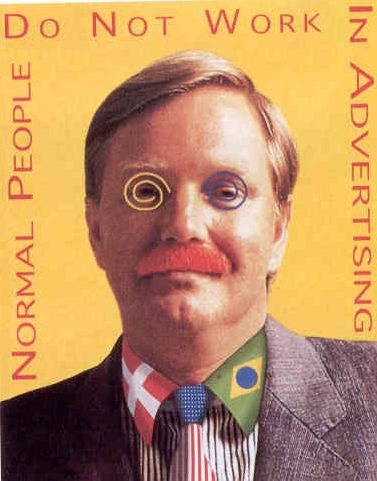 |
|
| CocaCola Argentina, 2000 |
Brazilian flag 8th grade grafite Escola Veracruz 2000 |
Pokemon Japan 2000 |
San Francisco, 1997 |
Airline magazine |
This quest for the meaning of the spirals has, for me, a precise birth date and place: visiting the baroque churches of Olinda and Recife, January of 1997. Well, to be true, before that I had spent hours discussing my dentist theories that things go better in the northern hemisphere because of the effect of coriolis force on the human "energy", directed to "the outside".
At the same time that I was having fun "discovering" spirals everywhere, including allowing myself to enjoy the barroque (I was a modernist radical till then), the feeling that I was taken over by this game was also frightening. How sane was I? It was unconfortable to realize that no one else saw as many spirals as I did. So I started the search for company. Hours spent in searching machines did not help much. As I mentioned before, I found too many witches, two books and one logodesigner. This drove me to write this page in english, to increase my chance of finding fellow maniacs. It is interesting to say more about the few ones I know.
In 1914, a certain Sir Theodore Andrea Cook published a book called "The curves of Life". The first paragraph of the preface says When my attention was first turned to the subject of spiral formations, more than twenty years ago, it was in connection with an artistic problem, rather than a biological question, that I investigated them. See how he begins? In page two we read It may be said that with very few exceptions, the spiral formation is intimately connected with the phenomena of life and growth. ... I have used the spiral formation (and specially the F spiral or ratio of Pheidias ) as a kind of key , not only to natural phenomena but to artistic and architectural phenomena as well... to formulate the laws of beauty. So, for him, the spiral is a symbol of beauty, because it also follows the golden ratio ratio of Pheidias. The book is as tortuous as its subject. It speaks of shells, plants, flowers, horns, left-handedness, a certain building of Leonardo da Vinci and the mathematics of Albert Dürer. I found the book when searching for spirals at Amazonbooks.com. I bought it in search of answers, but I found a very uncomfortable solidarity: Was he just one more person hypnotized by Carybdes maelstrom?
Another of such lunatics is Gustav R. Locke, who wrote
"Mannerism: the world as labyrinth".
The Spirals in Renaissance: the Neoplatonist Counterattack in XV century Firenzi
The first case I know of an S shaped volute in the façade of a church is the two discrete ones in Santa Maria Novella, in Florence, built around 1470 by Leon Battista Alberti. Firenzi was the center of a neoplatonist movement, brought about by the hundreds of Bizantium scholars that came for the Christian Council that was set to help the Eastern Emperor withhold the Turkish pressure. One of them, George Gemistos, aka Plethon, convinced Cosimo de Medici, the richest banker of the time, to create a Platonic Academy at around 1439. The Academy only took off when Marsilio Ficino joined in, in 1459, translating many of Plato's book from Greek to Latin. Botticelli was among the academians, as Leon Battista Alberti. In this milieu, Alberti introduced the volutes of Santa Maria Novella and Botticelli drew nice volutes in the throne of Fortezza.
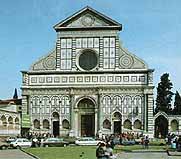 |
|||
| Santa Maria Novella Firenzi, 1470 |
Spirals in the baroque
The volutes of the baroque churches in Brazil.
Although in Europe volutes were been used in façades since 1470, they turned fashionable after Il Gesu, 1570. Very soon those volutes spread all over, specially in Germany. Heidelberg is filled with them: Hotel Ritter (1592), Friedrichsbau (1607).
The volutes only reached Brazilian façades in 1680, with the jesuitic church of Salvador, then the Portuguese colonial capital. There is an interesting theory that traces those volutes to the Rollwerk style design books of Vredeman de Vries. When Philip the 3rd, King of Spain and Portugal visited Lisbon, in 1619, many flemish artisans helped to prepare and adorn the city. Maybe those were the first volutes seen in Portugal. A few years later the Chapel of the Franciscan Third Order was built (also in Salvador), with richly adorned volutes, in a style not to be seen again in Brazil.
The Gold Rush, starting in the turn of the century, brought the money to fund church building exuberance never to be seen again. I think it is safe to say that all churches built in Brazil during the XVIII century had volutes. Salvador, Rio de Janeiro, Recife, the rebuilt churches of Olinda (after been burnt by the Dutch in 1630), Vila Rica (Ouro Preto) and many other Brazilian cities directly or indirectly involved in the gold flux from Minas Gerais to the ports (and then to England, via Lisbon) built wonderful churches. Most of them were funded by the Third Orders, church organizations for the laic.
For Olinda there is an interesting record: Fighting the Spanish crown that reigned over Portugal from 1580 to 1640, the dutch invaded the Brazilian northeast in 1630 and only left in 1654 (there is a statue in New York - near Ground Zero - honouring the first jews that there arrived - coming from Recife). The paintings made by Franz Post and others show the ruins of the burnt churches, all of them with the classical triangular front with no volutes. It is clear that only later, mostly in the XVIII century, those churches were rebuilt with volutes on their façade.
All churches had volutes, but they had different accents, from city to city. In Recife and Olinda they all have around five doors in the front, while in Minas Gerais they had only one. In the center of the gold province, some architects designed unique façades and plans, the most notable being Antonio Francisco Lisboa.
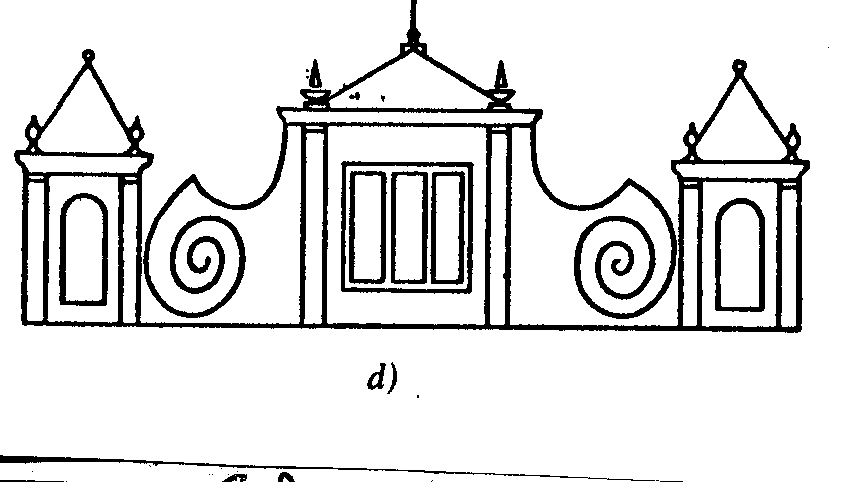 |
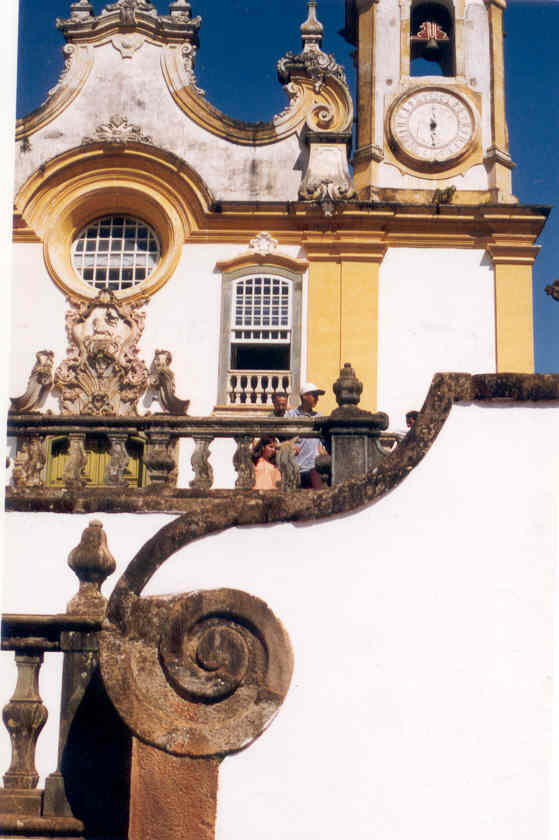 |
|||
| The façade of the Jesuit church, today the Cathedral Salvador, Bahia, 1680 |
Church of Santo Antonio. Tiradentes, Minas gerais, 1730 |
What happened in
Kopenhagen, in the XVII century?
I attended a scientific conference in Copenhagen in the year 2000. I
was very surprised to see so many spirals in the city skyline. I don't
think there is anywhere else in the world like that. All of them built
in the
XVII century. The building of the Purse has a worderful spiral spire,
in
fact the tails of two dragons. The Rundtower (an
observatory
built by king Christian IV to prove that his destruction of Tycho
Brahe's
Uraniborg was not due to hate of astronomy) has a spiral ramp to the
top
that was able to take Christian IV by horsecart all the way up
there.
The Burse, also built by Christian IV, was supposed to improve
Danish business
at a time when Denmark was a world power. Its spire contains 4 dragons
with
their intertwinned tails. However, Denmark participation in the ill
fated
"30 Years War" did not help their business and the Burse did not
work for more than 100 years.
Christian IV's son, Frederick, is famous for us, Brazilians, as the
receiver of a splendic set of paintings made in dutch Brazil by
Eckhout, in 1640. The
colletion is kept at the National Gallery, in Copenhagen. To my
surprise, no spirals can be seen on Eckhout paintings.
 |
 |
 |
| The Burse 1629 |
Vor Frelsers Kirke The Church of Our Saviour, 1696-1752 |
The Rundtower |
Spirals in Western History
Spirals come and go through out western history. We may say it has
not lasted long, lately. Spirals were fashionable for centuries among
the brightest Greeks, in the volutes of the jonic capital. It almost
disappeared from architecture during the middle ages. There are no
spirals in heraldics. It made a discrete reentrance in the renaissance,
as if preparing the western world for the complete takeover of the
baroque and rococo. Then it reigned during 250 years. In Brazil, there
is no church built or rebuilt from 1680 to 1800 that did not have
immense volutes in the façade, not to mention myriads of spirals
in the internal deco. The neo-classic hangover took a hundred
years, interrupted by the brief Art Nouveau only to totally disappear
under
the modernist absolutism. The brief resurgence with the hippies did not
last
much, and now it came back so discrete it seems disguised. Such a rich
cyclic
history has to have a meaning. Or is it just fortuitous, fashion, as
usual?
 |
 |
 |
|
|
|
|
|
|
|
Spiral in the Sun Flyer, Boston, 2000 |
Whenever the spiral subject is brought up, someone remembers the chirality of water going down the drain, the airplane-water-sink test over the equator, even some TV programs about the correct site of the equator line in Quito, (Equador), or somewhere else . Some want to connect it to a Coriolis effect. Have you made the experiment yourself? I have. The result is disappointing. Sometimes the water turn in one direction, sometimes in other. In some sinks it may go to one direction, but other in another room will turn the opposite sense. Dr. Alistair B. Fraser, from Penn State, in his site Bad Science, shows in detail all about this non-sense! There is a very good joke correlating the sense of the water down the drain and the explanation of the existence of 220V.
Coriolis Spirals
This is a good one. Grolier Encyclopedia says:
{kohr-ee-oh'-lis}The Coriolis effect, named for French physicist Gaspard Coriolis (1792-1843), is an imaginary force that appears to be exerted on an object moving within a rotation system. The apparent force is simply the ACCELERATION of the object caused by the rotation. For example, if a line were being drawn toward the center of a stationary wheel that then began to rotate, an observer in some way unaware of the rotation would note its effects as an apparent force being exerted at an angle to the progress of the line. This effect is seen on a large scale in the movement of winds and ocean currents on the rotating Earth. It dominates weather patterns, producing the counterclockwise flow observed around low-pressure zones in the Northern Hemisphere and the clockwise flow around such zones in the Southern Hemisphere.
In physics, the Coriolis effect is an example of the conservation of ANGULAR MOMENTUM. An object moving without any external force on it must move in such a way that its angular momentum remains constant. If a spinning object moves closer to its axis of rotation its angular velocity must increase, as when a spinning skater's arms are pulled closer to the body, increasing the rate of spin. Similarly, the motion of a wind blowing northward along the surface of the Earth in the Northern Hemisphere reduces the distance of the air mass from the Earth's axis. Its angular velocity increases, forcing it to move eastward. Missile and satellite trajectories must also take into account the Coriolis effect produced by the Earth's rotation, but on a smaller scale this is usually not necessary because motions are then dominated by the force gravity.
Spirals in Esoterics
If you put the word spiral in a search machine in the web you will find, besides lots of spiral staircases, quite a number of esoteric spirals.
http://www.alphaomega.se/english/spirale.html was one of the most interesting. Aron Vaughn writes " The spiral is an archetype which has existed in cultures around the world since the very beginning of civilization. It symbolizes the movement of consciousness toward self understanding, the journey of both the individual and humanity searching both outwardly and inwardly toward truth, that most untouched, mysterious and beautiful holy of holies, the "I" itself."